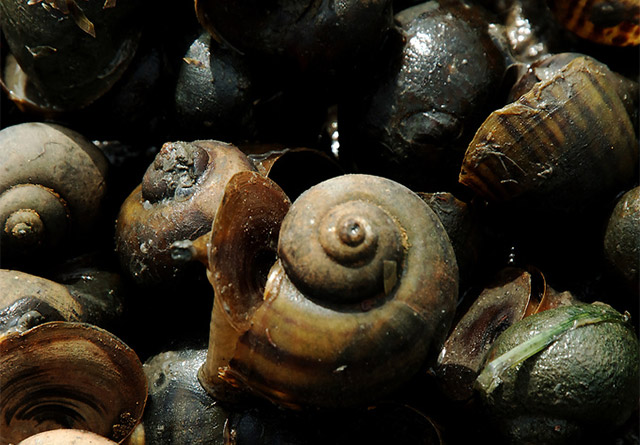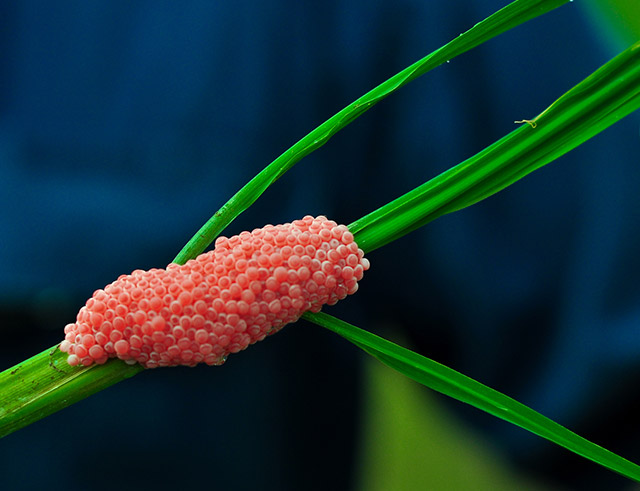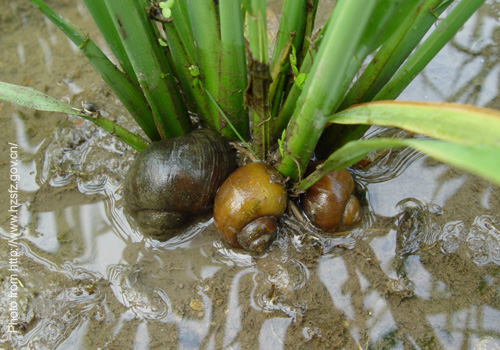Golden Apple Snail
 There are more than 100 species of apple snail that exists.
There are more than 100 species of apple snail that exists.
Two species, Pomacea canaliculata and Pomacea maculata, commonly known as Golden Apple Snails, are highly invasive and cause damage to rice crops.
They were introduced to Asia, from South America, in the 1980s as potential food for people, but it unfortunately became a major pest of rice.
What it does
Golden apple snails eat young and emerging rice plants. They cut the rice stem at the base, destroying the whole plant.
Why and where it occurs
Snails are able to spread through irrigation canals, natural water distribution pathways, and during flooding events.
When water is absent, apple snails are able to bury themselves in the mud and hibernate for up to six months . When water is re-applied to fields, snails may emerge.
They damage direct wet-seeded rice and transplanted rice up to 30 days old. Once the rice plant reaches 30−40 days, it will become thick enough to resist the snail.
How to identify
To distinguish golden apple snails from native snails, check its color and size.
Golden apple snails have muddy brown shell and golden pinkish or orange-yellow flesh. They are bigger and lighter in color compared to native snails. Its eggs are bright pink in color.
To confirm snail damage, check for missing hills, cut leaves, and cut stems.
Why is it important
The golden apple snail is considered a major problem of rice.
If no control measure is taken, they can completely destroy 1 m2 of field overnight. This damage could lead to more than 50% yield loss.
How to manage
The critical time to manage golden apple snails is during land preparation and crop establishment or planting; specifically, first 10 days after transplanting (DAT), and during the first 21 days after direct wet-seeding.
After this, the crop is generally resistant to snail damage and snails are actually beneficial by feeding on weeds.
Community-based snail management
To best control the snail, communities should work together to reduce snail numbers in their area.
- Conduct mass snail and egg collection campaigns, involving the whole community, during land preparation and planting or crop establishment.
- Keep fields drained as much as possible during the vulnerable stages of the rice plant (below 30 days) or transplant 25−30 day old seedlings from low density nursery beds.
Biological control
- Encourage natural predators.
- Red ants feed on the snail eggs while ducks (and sometimes rats) will eat young snails. Several wild bird species have also adapted to feed on golden apple snails and domestic ducks can be put into fields during final land preparation or after crop establishment when plants are big enough (e.g., 30−35 DAT).
- Snails can also be harvested, cooked and eaten or sold as animal feed. However, it is important to take extra care and cook the snails thoroughly, as they are known carriers of the rat lungworm.
Cultural control
- Handpick snails
Handpick snails and crush egg masses. This is best done in the morning and afternoon when snails are most active. Place bamboo stakes to provide sites for egg laying that allows easy collection of snail eggs for destruction.
You can also use attractants or plants that attract snails, such as papaya and cassava leaves, to make hand picking easier.
- Manage water
Apple snails have difficulty moving in less than 2 cm of water. Keep water level below 2 cm during the vulnerable stages of the rice plant.
Construct small canals or canalettes (e.g., 15−25 cm wide and 5 cm deep) after the final land preparation. Pull a sack containing a heavy object around the edges of rice paddies or at 10−15 m intervals. Canalettes facilitate drainage and act as focal points for snails making manual collection or killing easier.
- Use toxic plants
Place toxic plants, such as tobacco leaves, heartleaf false pickerelweed, and citrus leaves in strips across the field or in canalettes.
- Prevent field entry
Know your water flow. Snails can invade fields from canals, rivers, and reservoirs.
Place a barrier where water enters and exits the field. Place a wire or woven bamboo screen or mesh bag on the main irrigation water inlet and outlet to prevent snail entry.
- Transplant
Transplanted rice is less vulnerable than direct seeded rice.
Plant healthy and vigorous seedlings. Raise seedlings in low density nursery beds, i.e., less than 100 g seeds per m2 and delay transplanting (e.g., transplant 25−30 day-old seedlings).
To reduce missing hills from snail damage, multiple seedlings per hill can be planted.
Chemical control
Sometimes chemical control may be needed if other practices fail. Check locally available products that have low toxicity to humans and the environment.
Following normal fertilizer application rate and schedule, apply fertilizer in 2 cm of water to maximize negative effects on apple snails.
- Apply products only to low spots and canalettes rather than to the whole field. Always ensure safe application.
- If used, molluscicides should only be used immediately after transplanting or during the seedling establishment phase in direct seeded rice; and only for rice younger than 30 days old.

